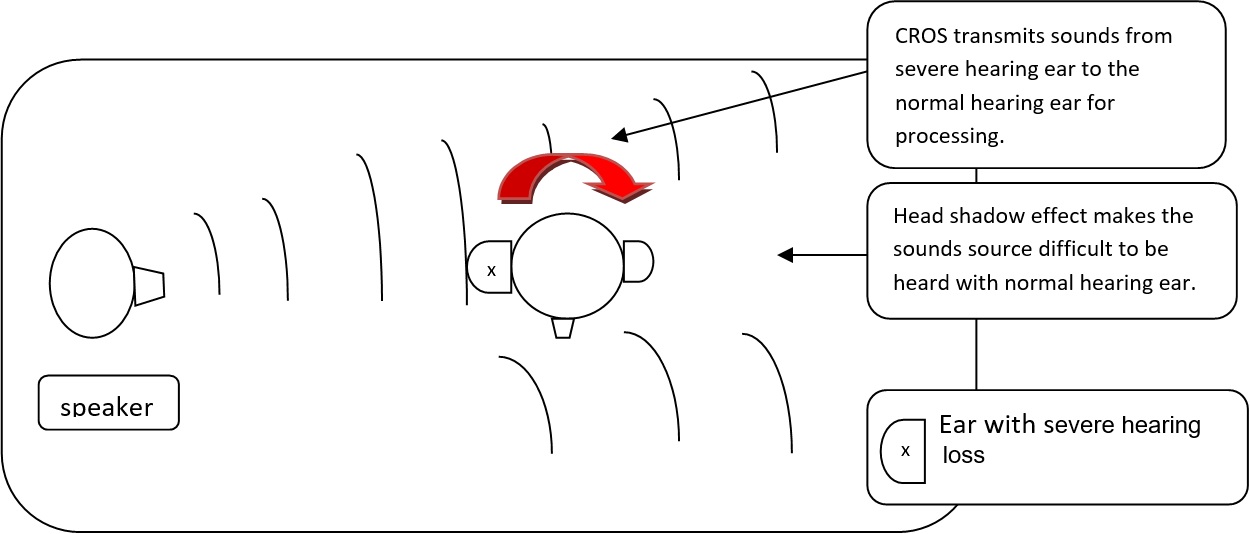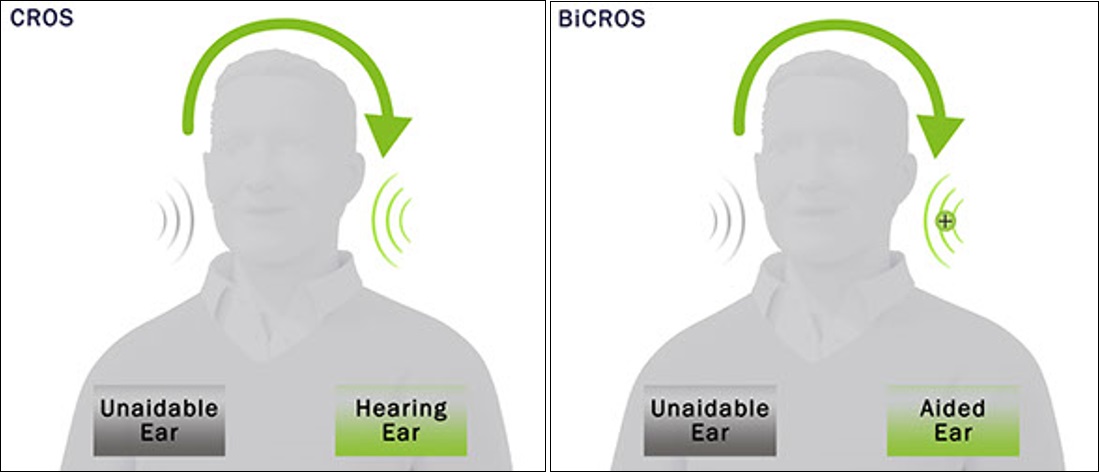Hearing aids are vary in style, there are behind the ear hearing aids, in the ear hearing aids, in the canal hearing aids and CROS and BiCROS hearing aids. Each of these styles has the form and the use that suit patient or user appropriateness.
For patient with severe to profound single sided deafness or unilateral hearing loss, they may have significant problem to identify the direction of the sound source due to head shadow effect. Sounds that coming from the ears with severe hearing loss will be prevented by the head to be transmitted to the good ear. This situation makes it difficult for the patient to hear sounds clearly, especially in a noisy place (Kinkell, 2011).
What is CROS
CROS is the abbreviation of Contralateral Routing of Signal is specially designed for user with severe to profound single sided deafness. Which the ear cannot be helped by conventional hearing aids, CROS is a technology that uses a microphone system to be put in the ear with severe hearing loss that receive sounds or signals of the direction and sends it to the normal hearing ear for processing.

CROS beneficial to these patients to hear more clearly when the sounds or speech coming from the bad ear. This can help patients to communicate better from both directions or sounds. CROS technology can only help patients who have normal hearing side to process the signal from severe ear. For patients who have hearing loss in both ears, which is very severe in one ear and mild to moderately severe in the other ear, BiCROS technology is more suitable for this group.
What is BiCROS
BiCROS is the acronym for Bilaterally Contralateral Routing of Signal; it has the same concept as CROS that send signals from severe ear to the normal hearing ear for processing. The technology distinguishes CROS and BiCROS by the system of reception and transmission of sound. CROS has a transmitter to receive sound from severe ear and send to a normal hearing ear, receiver in the normal hearing ear will receive the signals and processed by the ear naturally since the auditory organ is in good condition. In contrast to the BiCROS system, the transmitter receives sound from severe ear and sends to the better hearing ear, receiver in the better ear will receive the signals and send to amplifier to amplify the signals. Lastly the signal is transmit to the better ear to hear. Amplifier is required in BiCROS as the better ear unable to process signals naturally due to hearing problems.

Source : http://www.absolutehearing.ca/hearing-aids.html
Advantages of CROS and BiCROS
Transmitter and receiver in both CROS and BiCROS are connected via a wireless radio technology that is allowing patients to live in a more comfortable life. There are many advantages obtained from CROS and BiCROS technology, among which is to help patients hear more clearly from the bad ear where patients no longer need to turn their head or body in order to hear from severe hearing ear. Secondly, this technology helps to improve the quality of sound since the patient will hear the sound louder and clear as the hearing with both ears were able to amplify the sound of 3db up to 6 dB (Staab, 2015). Patients also can get some cues abaout the location of the sound. Furthermore, the hearing process will be easier and less tiring as sound heard is more balanced. Finally, a patient’s quality of life can be improved, both socially and emotionally.
Disadvantages of CROS and BiCROS
CROS and BiCROS technology are designed to overcome the head shadow effect. It works well and is very helpful in communication in a quiet place. But the study showed that the CROS and BiCROS does not provide optimal benefits in a noisy environment, particularly in the classroom. Therefore some communication strategies for patients and families can put into practice. Among them avoid communicating in a noisy place or reducing some environment noise. Second, talk with clear and short paragraph so that the patient can understand it. Next, get the patient’s attention before starting a conversation to make them more ready and focused to listen (Dillon, 2011).
Summary
|
CROS |
BiCROS |
|
|
Definition |
Contralateral Routing of Signal |
Bilaterally Contralateral Routing of Signal |
|
For whom |
Those who has severe single sided hearing loss and normal hearing on the other ear (unilateral hearing loss) |
For those who has both hearing loss with one ear is severe loss and the other is better (bilateral asymmetrical hearing loss) |
|
Technology |
Has microphone, transmitter and receiver |
Has microphone, transmitter, receiver and amplifier |
Conclusion
Finally, with the selection of appropriate hearing aids and some effective communication techniques, the quality of life for patients who has severe hearing loss in one ear can be improved.
References
- Dillon,H. (2001).Counselling the new hearing aid wearer. In Dillon,H (Ed.), Hearing aids (pp332-337). New York: Boomerang Press.
- Hearing Aid Review: Cros and BiCros (2013). PeopleHearingBetter. Retrieved July 25,2015, from http://www.Secondsensehearing.com/content/hearing-aid-reviews-cros-and-bicros
- Kinkell, M. (2011). Cutting the Wire: What’s New in CROS/BiCROS Technology?. AudiologyOnline. Retrieved July 25,2015, from http://www.audiologyonline.com/articles/cutting-wire-what-s-new-791
- Staab, W.(2015). Binaural Loudness Summation. Hearinghealthmatters. Retrieved August 8,2015, from http://hearinghealthmatters.org/waynesworld/2015/binaural-loudness-summation/
| Last Reviewed | : | 4 August 2017 |
| Writer/Translator | : | Hayati Muhamad bt. Rusli |
| Accreditor | : | Juliana bt. Samsudin |







